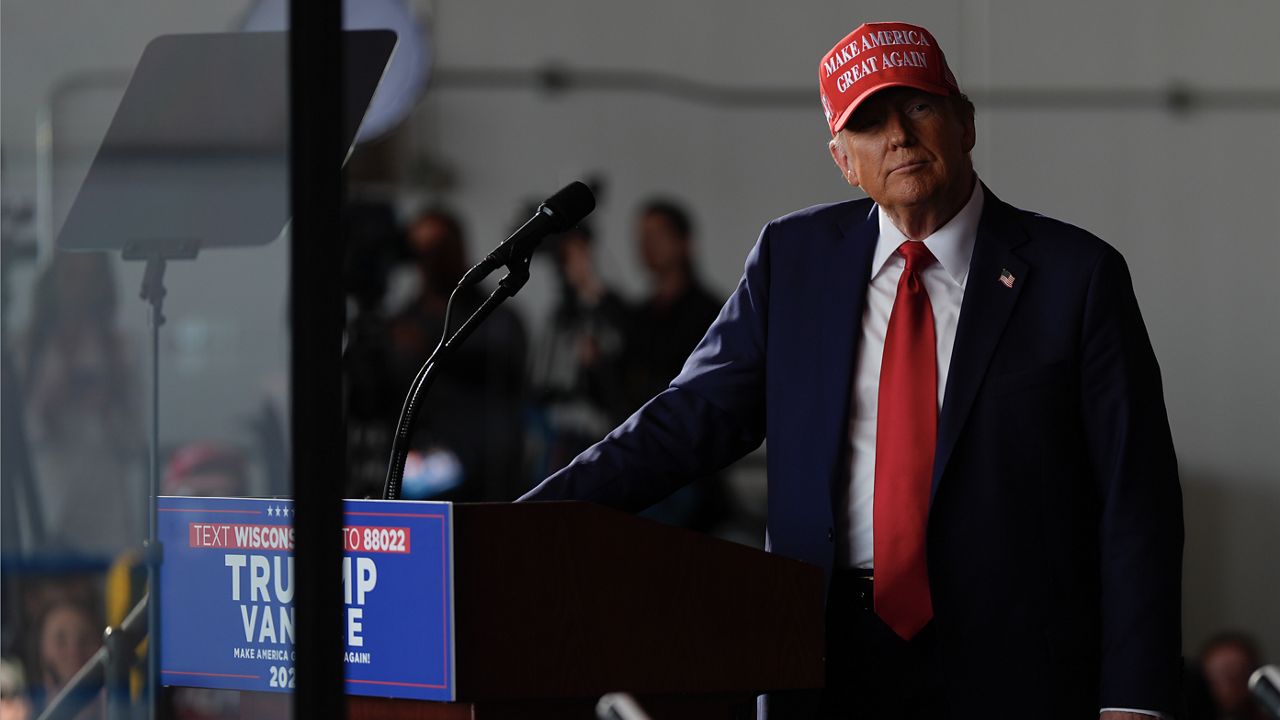Donald Trump on Sunday visited Wisconsin for the fourth time in eight days as his campaign showers attention on a pivotal state where Republicans fret about his ability to match Democrats’ enthusiasm and turnout machine.
“They say that Wisconsin is probably the toughest of the swing states to win," Trump said in his opening remarks at an airplane hangar in a rural Juneau where the overflow crowd spilled out on to the tarmac. "I don’t think so.”
Voters in Wisconsin are already casting absentee ballots and in-person early voting begins Oct. 22. Trump encouraged supporters to vote by mail and early, when the time comes, so they turn out “in record numbers.”
Wisconsin is perennially tight in presidential elections but has gone for the Republicans just once in the past 40 years, when Trump won the state in 2016. A win in November could make it impossible for Democratic nominee Kamala Harris to take the White House.
“In the political chatter class, they’re worried,” said Brandon Scholz, a retired Republican strategist and longtime political observer in Wisconsin who voted for Trump in 2020 but said he is not voting for Trump or Harris this year. “I think Republicans are right to be concerned.”
Trump won the state in 2016 over Democrat Hillary Clinton by fewer than 23,000 votes and lost to Democrat Joe Biden in 2020 by just under 21,000 votes.
On Tuesday, Trump made his first-ever visit to Dane County, home to the liberal capital city of Madison, in an effort to turn out the Republican vote even in the state's Democratic strongholds. Dane is Wisconsin’s second most-populous and fastest-growing county; Biden received more than 75% of the vote four years ago.
“To win statewide you’ve got to have a 72-county strategy,” former Gov. Scott Walker, a Republican, said at that event.
Juneau is a a town of 2,000 about 50 miles north of Madison in Dodge County, which Trump won in 2020 with 65% of the vote.
Early arrivals filled the hangar, far exceeding the available seating. One large banner behind the bleachers inside said “Vote Early.”
“Make sure we turn out because guess what, I’ve been to Madison,” said U.S. Rep. Scott Fitzgerald, who is from Juneau, at the event. “I’ve been to liberal Madison and they’re going to show up. We need to do the same thing because we are the firewall to keep this country independent and free.”
Jack Yuds, chairman of the county Republican Party, said support for Trump is stronger in this part of the state than it was in 2016 or 2020.
“I can’t keep signs in,” Yuds said. “They want everything he’s got. If it says Trump on it, you can sell it.”
Trump’s campaign and outside groups supporting his candidacy have outspent Harris and her allies on advertising in Wisconsin, $35 million to $31 million, since she became a candidate on July 23, according to the media-tracking firm AdImpact.
Harris and outside groups supporting her candidacy had more advertising time reserved in Wisconsin from Oct. 1 through Nov. 5, more than $25 million compared with $20 million for Trump and his allies.
The Harris campaign has 50 offices across 43 counties with more than 250 staff in Wisconsin, said her spokesperson Timothy White. The Trump campaign said it has 40 offices in the state and dozens of staff.
Harris rallied supporters in Madison in September at an event that drew more than 10,000 people. On Thursday, she made an appeal to moderate and disgruntled conservatives by holding an event in Ripon, the birthplace of the Republican Party, along with former U.S. Rep. Liz Cheney of Wyoming, one of Trump’s most prominent Republican antagonists.
Harris and Trump are focusing on Wisconsin, Michigan and Pennsylvania, the “blue wall” states that went for Trump in 2016 and flipped to Biden in the next election.
While Trump’s campaign is bullish on its chances in Pennsylvania as well as Sunbelt states, Wisconsin is seen as more of a challenge.
“Wisconsin, tough state,” said Trump campaign senior adviser Chris LaCivita, who worked on Republican Sen. Ron Johnson’s winning reelection campaign in 2022.
“I mean, look, that’s going to be a very tight — very, very tight, all the way to the end. But where we are organizationally now, comparative to where we were organizationally four years ago, I mean, it’s completely different,” LaCivita said.
He also cited Michigan as more of a challenge. “But again, these are states that Biden won and carried and so they’re going to be brawls all the way until the end and we’re not ceding any of that ground.”
The candidates are about even in Wisconsin, based on a series of polls that have shown little movement since Biden dropped out in late July. Those same polls also show high enthusiasm among both parties.
Mark Graul, who ran then-President George W. Bush’s 2004 campaign in Wisconsin, said the number of campaign visits speaks to Wisconsin’s decisive election role.
The key for both sides, he said, is persuading infrequent voters to turn out.
“Much more important, in my opinion, than rallies,” Graul said.



